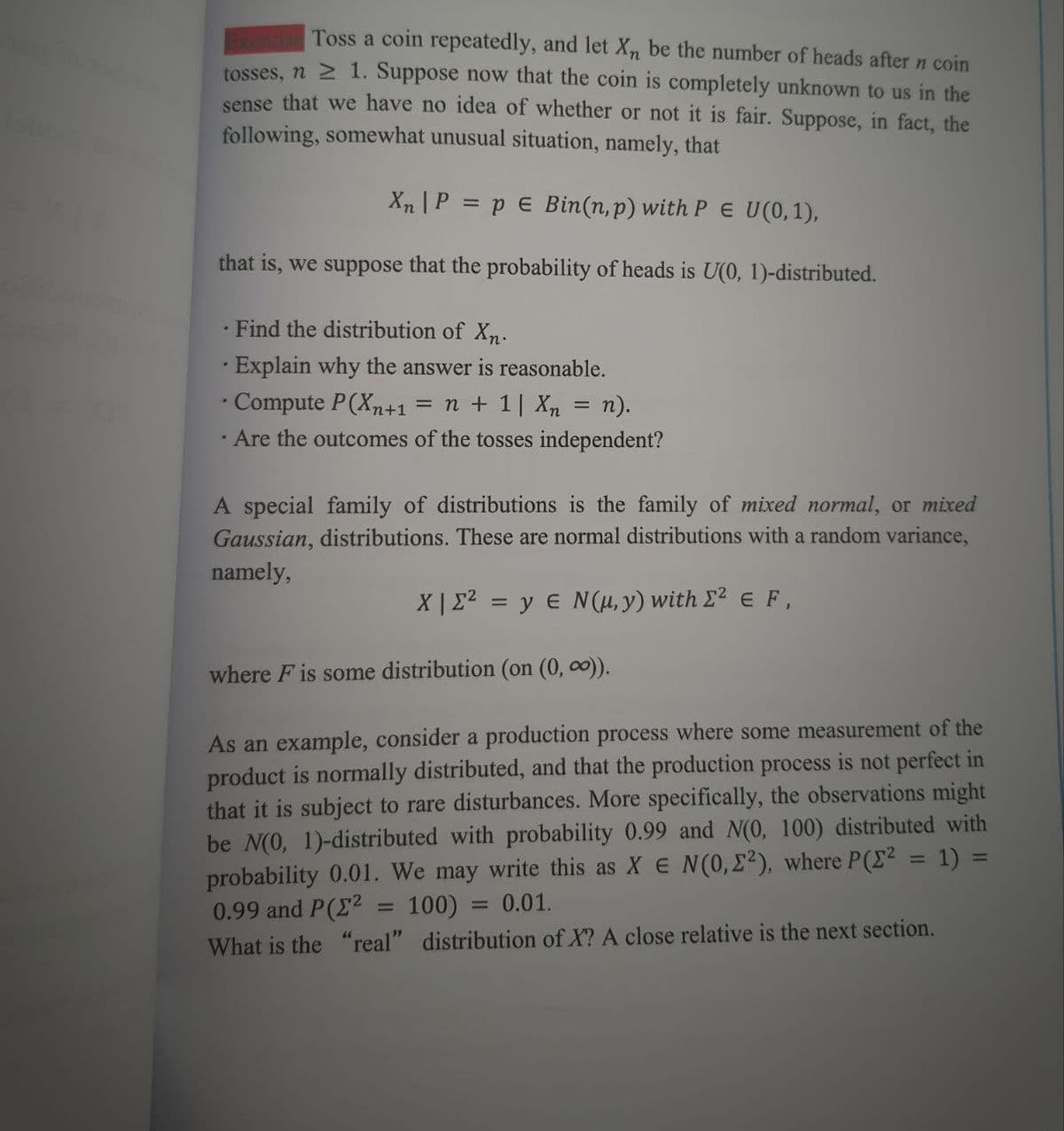Toss a coin repeatedly, and let Xn be the number of heads after n coin tosses, n ≥ 1. Suppose now that the coin is completely unknown to us in the sense that we have no idea of whether or not it is fair. Suppose, in fact, the following, somewhat unusual situation, namely, that Xn | P = p E Bin(n, p) with PE U(0,1), that is, we suppose that the probability of heads is U(0, 1)-distributed. . Find the distribution of Xn- · Explain why the answer is reasonable. . • Compute P(Xn+1 = n + 1 | Xn = n). . Are the outcomes of the tosses independent? A special family of distributions is the family of mixed normal, or mixed Gaussian, distributions. These are normal distributions with a random variance, namely, X|² = y = N(u, y) with 2² EF, where F is some distribution (on (0, ∞)). As an example, consider a production process where some measurement of the product is normally distributed, and that the production process is not perfect in that it is subject to rare disturbances. More specifically, the observations might be N(0, 1)-distributed with probability 0.99 and N(0, 100) distributed with :1) = probability 0.01. We may write this as X E N(0,2²), where P(² 0.99 and P(² = 100) = 0.01. What is the "real" distribution of X? A close relative is the next section.
Toss a coin repeatedly, and let Xn be the number of heads after n coin tosses, n ≥ 1. Suppose now that the coin is completely unknown to us in the sense that we have no idea of whether or not it is fair. Suppose, in fact, the following, somewhat unusual situation, namely, that Xn | P = p E Bin(n, p) with PE U(0,1), that is, we suppose that the probability of heads is U(0, 1)-distributed. . Find the distribution of Xn- · Explain why the answer is reasonable. . • Compute P(Xn+1 = n + 1 | Xn = n). . Are the outcomes of the tosses independent? A special family of distributions is the family of mixed normal, or mixed Gaussian, distributions. These are normal distributions with a random variance, namely, X|² = y = N(u, y) with 2² EF, where F is some distribution (on (0, ∞)). As an example, consider a production process where some measurement of the product is normally distributed, and that the production process is not perfect in that it is subject to rare disturbances. More specifically, the observations might be N(0, 1)-distributed with probability 0.99 and N(0, 100) distributed with :1) = probability 0.01. We may write this as X E N(0,2²), where P(² 0.99 and P(² = 100) = 0.01. What is the "real" distribution of X? A close relative is the next section.
Algebra and Trigonometry (MindTap Course List)
4th Edition
ISBN:9781305071742
Author:James Stewart, Lothar Redlin, Saleem Watson
Publisher:James Stewart, Lothar Redlin, Saleem Watson
Chapter14: Counting And Probability
Section14.2: Probability
Problem 3E: The conditional probability of E given that F occurs is P(EF)=___________. So in rolling a die the...
Related questions
Question

Transcribed Image Text:Toss a coin repeatedly, and let X₁, be the number of heads after n coin
tosses, n ≥ 1. Suppose now that the coin is completely unknown to us in the
sense that we have no idea of whether or not it is fair. Suppose, in fact, the
following, somewhat unusual situation, namely, that
Xn | P = p = Bin(n, p) with PE U(0,1),
that is, we suppose that the probability of heads is U(0, 1)-distributed.
• Find the distribution of Xn.
• Explain why the answer is reasonable.
Compute P(Xn+1 = n + 1| Xn = n).
.
Are the outcomes of the tosses independent?
A special family of distributions is the family of mixed normal, or mixed
Gaussian, distributions. These are normal distributions with a random variance,
namely,
X|22 = y EN(μ,y) with Σ2 € F,
where F is some distribution (on (0, ∞)).
As an example, consider a production process where some measurement of the
product is normally distributed, and that the production process is not perfect in
that it is subject to rare disturbances. More specifically, the observations might
be N(0, 1)-distributed with probability 0.99 and N(0, 100) distributed with
probability 0.01. We may write this as X E N(0,22), where P(x² = 1) =
0.99 and P(² 100)
0.01.
=
What is the "real" distribution of X? A close relative is the next section.
Expert Solution
This question has been solved!
Explore an expertly crafted, step-by-step solution for a thorough understanding of key concepts.
This is a popular solution!
Trending now
This is a popular solution!
Step by step
Solved in 4 steps with 5 images

Recommended textbooks for you

Algebra and Trigonometry (MindTap Course List)
Algebra
ISBN:
9781305071742
Author:
James Stewart, Lothar Redlin, Saleem Watson
Publisher:
Cengage Learning

College Algebra
Algebra
ISBN:
9781305115545
Author:
James Stewart, Lothar Redlin, Saleem Watson
Publisher:
Cengage Learning

College Algebra (MindTap Course List)
Algebra
ISBN:
9781305652231
Author:
R. David Gustafson, Jeff Hughes
Publisher:
Cengage Learning

Algebra and Trigonometry (MindTap Course List)
Algebra
ISBN:
9781305071742
Author:
James Stewart, Lothar Redlin, Saleem Watson
Publisher:
Cengage Learning

College Algebra
Algebra
ISBN:
9781305115545
Author:
James Stewart, Lothar Redlin, Saleem Watson
Publisher:
Cengage Learning

College Algebra (MindTap Course List)
Algebra
ISBN:
9781305652231
Author:
R. David Gustafson, Jeff Hughes
Publisher:
Cengage Learning

Algebra & Trigonometry with Analytic Geometry
Algebra
ISBN:
9781133382119
Author:
Swokowski
Publisher:
Cengage
